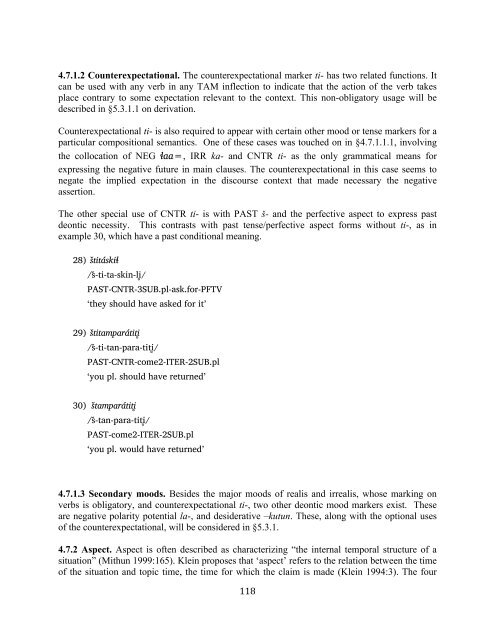The phonology and morphology of Filomeno Mata Totonac
The phonology and morphology of Filomeno Mata Totonac
The phonology and morphology of Filomeno Mata Totonac
You also want an ePaper? Increase the reach of your titles
YUMPU automatically turns print PDFs into web optimized ePapers that Google loves.
4.7.1.2 Counterexpectational. <strong>The</strong> counterexpectational marker ti- has two related functions. It<br />
can be used with any verb in any TAM inflection to indicate that the action <strong>of</strong> the verb takes<br />
place contrary to some expectation relevant to the context. This non-obligatory usage will be<br />
described in §5.3.1.1 on derivation.<br />
Counterexpectational ti- is also required to appear with certain other mood or tense markers for a<br />
particular compositional semantics. One <strong>of</strong> these cases was touched on in §4.7.1.1.1, involving<br />
the collocation <strong>of</strong> NEG "aa=, IRR ka- <strong>and</strong> CNTR ti- as the only grammatical means for<br />
expressing the negative future in main clauses. <strong>The</strong> counterexpectational in this case seems to<br />
negate the implied expectation in the discourse context that made necessary the negative<br />
assertion.<br />
<strong>The</strong> other special use <strong>of</strong> CNTR ti- is with PAST #- <strong>and</strong> the perfective aspect to express past<br />
deontic necessity. This contrasts with past tense/perfective aspect forms without ti-, as in<br />
example 30, which have a past conditional meaning.<br />
28) s%titáski"<br />
/s"-ti-ta-skin-li&/<br />
PAST-CNTR-3SUB.pl-ask.for-PFTV<br />
‘they should have asked for it’<br />
29) s%titamparátiti&<br />
/s"-ti-tan-para-titi&/<br />
PAST-CNTR-come2-ITER-2SUB.pl<br />
‘you pl. should have returned’<br />
30) s%tamparátiti&<br />
/s"-tan-para-titi&/<br />
PAST-come2-ITER-2SUB.pl<br />
‘you pl. would have returned’<br />
4.7.1.3 Secondary moods. Besides the major moods <strong>of</strong> realis <strong>and</strong> irrealis, whose marking on<br />
verbs is obligatory, <strong>and</strong> counterexpectational ti-, two other deontic mood markers exist. <strong>The</strong>se<br />
are negative polarity potential la-, <strong>and</strong> desiderative –kutun. <strong>The</strong>se, along with the optional uses<br />
<strong>of</strong> the counterexpectational, will be considered in §5.3.1.<br />
4.7.2 Aspect. Aspect is <strong>of</strong>ten described as characterizing “the internal temporal structure <strong>of</strong> a<br />
situation” (Mithun 1999:165). Klein proposes that ‘aspect’ refers to the relation between the time<br />
<strong>of</strong> the situation <strong>and</strong> topic time, the time for which the claim is made (Klein 1994:3). <strong>The</strong> four<br />
! "",!

















